PR-6171IRE Science A STEM Approach - 1st Class
Create successful ePaper yourself
Turn your PDF publications into a flip-book with our unique Google optimized e-Paper software.
Unit Overview<br />
Living Things<br />
CREATURE FEATURES IN DIFFERENT PLACES<br />
<strong>Science</strong> Learning Concepts:<br />
• Observe, identify and explore a variety of living things from local and wider environments.<br />
• Recognise and describe the parts of some living things.<br />
• Appreciate that living things have essential needs for growth.<br />
Lesson 1<br />
Where are living things found<br />
and what external features<br />
do they have to help them<br />
survive?<br />
Lesson 2<br />
Where do animals live and<br />
what external features do they<br />
have that help them survive?<br />
Lesson 3<br />
What animals live in the ocean<br />
and what body parts do they<br />
have that help them survive?<br />
Lesson 4<br />
What animals live in Irish<br />
woodlands and what body<br />
parts do they have that help<br />
them survive?<br />
Lesson 5<br />
What insects live in the garden<br />
and what body parts do they<br />
have to help them survive?<br />
Lesson 6<br />
What are the parts of a plant<br />
and what does each part do?<br />
Lesson 7<br />
Why do plants from different<br />
habitats look different?<br />
Summative Assessment<br />
<strong>STEM</strong> Project<br />
Alien Animals<br />
Pupils recall prior knowledge to establish what they<br />
know about what living things need, the features of living<br />
things and where they live.<br />
Pupils explore four different habitats (pond, desert,<br />
woodland and coast) and the animals that live there<br />
through an interactive website. They learn about the<br />
body parts of the animals that live there and how they<br />
help them survive.<br />
Pupils investigate animals that live at the beach and<br />
underwater. The external features of fish, sharks and sea<br />
turtles are explored and labelled, with the aid of research<br />
via QR codes that link to videos.<br />
Pupils observe and investigate common footprints made<br />
by Irish woodland animals, including the rabbit, squirrel,<br />
badger and fox. Pupils then focus on the rabbit and<br />
create a fact minibook, labelling the rabbit’s external<br />
features and investigating how it uses its body parts to<br />
live in the woodland.<br />
Pupils explore creatures found in the garden by playing<br />
an interactive game. Pupils then explore by themselves<br />
by photographing an insect from their own locality and<br />
finding information about it. Pupils create a ‘creature fact<br />
file’ to present their information and include a labelled<br />
photograph.<br />
Pupils examine the common parts of a plant and use<br />
an interactive game to label a plant and understand<br />
the function of its features. Pupils then observe and<br />
investigate an actual plant and prepare an alien report<br />
explaining the parts of a plant and their functions.<br />
Viewing sample<br />
Pupils think about what plants belong in the desert and<br />
the rainforest. They focus on leaves and the function of<br />
leaves to observe and investigate a cactus and a leaf from<br />
a rainforest plant and explain why the leaves are different.<br />
Pupils draw an animal in its habitat and label the body<br />
parts, as well as draw a regular garden plant and its<br />
features and compare it to a desert or rainforest plant.<br />
Pupils apply their knowledge of animal features and<br />
functions to create an alien animal using a website<br />
game. Pupils then design and make a 3-D display model<br />
suitable for the animal.<br />
Pages<br />
4–6<br />
7–12<br />
13–18<br />
19–30<br />
31–34<br />
35-38<br />
39–43<br />
44–46<br />
47–54<br />
2 <strong>Science</strong>:<br />
A <strong>STEM</strong> AP<strong>PR</strong>OACH<br />
<strong>1st</strong><br />
CLASS<br />
978-1-912760-15-2 Prim-Ed Publishing – www.prim-ed.com


















